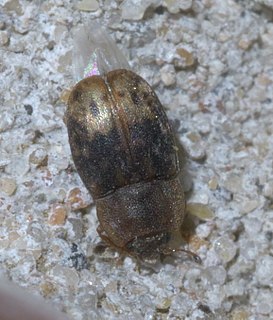
Matricaria discoidea, commonly known as pineappleweed, wild chamomile, and disc mayweed, is an annual plant native to northeast Asia where it grows as a common herb of fields, gardens, and roadsides. It is in the family Asteraceae. The flowers exude a chamomile/pineapple aroma when crushed. They are edible and have been used in salads and to make herbal tea. Pineappleweed has been used for medicinal purposes, including for relief of gastrointestinal upset, infected sores, fevers, and postpartum anemia.

Layia discoidea is a rare species of flowering plant in the daisy family known by the common name rayless tidytips, or rayless layia.
Brintonia is a monotypic genus of flowering plants in the sunflower family, containing the single species Brintonia discoidea, named for Jeremiah Bernard Brinton. It is known commonly as the rayless mock goldenrod. It is native to the southeastern United States, where it is distributed in Alabama, Florida, Georgia, Louisiana, and Mississippi.

Margaritaria discoidea is a tree in the family Phyllanthaceae, commonly known as the pheasant-berry, egossa red pear or bushveld peacock-berry. These trees are native to the warmer, higher rainfall areas of Africa.

Omosita is a genus of sap beetles, erected by Wilhelm Ferdinand Erichson in 1843.
Tolidomordella discoidea is a species of beetle in the genus Tolidomordella of the family Mordellidae. It was described in 1845.

Pseudoliotina discoidea, common name the discoid delphinula, is a species of small sea snail, a marine gastropod mollusk, in the family Liotiidae.
Acmaeops discoideus is a long-horned beetle in the flower longhorn subfamily, Lepturinae. It is found in the United States and Canada, and feeds on Virginia pine.

Languria is a genus of lizard beetles in the family Erotylidae. There are about 18 described species in Languria.

Omosita nearctica is a species of sap-feeding beetle in the family Nitidulidae.

Omosita colon is a species of sap-feeding beetle in the family Nitidulidae. It is found in Europe and Northern Asia, Central America, and North America.
Ginglymocladus is a genus of false soldier beetles in the family Omethidae. There are at least two described species in Ginglymocladus.
Ginglymocladus discoidea is a species of false soldier beetle in the family Omethidae. It is found in North America.
Loedelia is a genus of checkered beetles in the family Cleridae. There are at least three described species in Loedelia.
Ora discoidea is a species of marsh beetle in the family Scirtidae. It is found in Central America.
Loedelia discoidea is a species of checkered beetle in the family Cleridae. It is found in North America.
Pyrota discoidea is a species of blister beetle in the family Meloidae. It is found in North America.

Disonycha discoidea, the passionflower flea beetle, is a species of flea beetle in the family Chrysomelidae. It is found in North America.
Languria discoidea is a species of lizard beetle in the family Erotylidae. It is found in North America.








